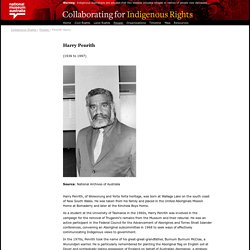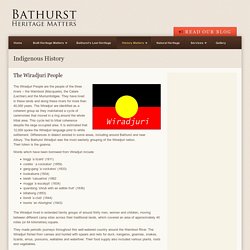

Burnum Burnum. (1936 to 1997) Source: National Archives of Australia Harry Penrith, of Woiworung and Yorta Yorta heritage, was born at Wallaga Lake on the south coast of New South Wales.

He was taken from his family and placed in the United Aboriginals Mission Home at Bomaderry and later at the Kinchela Boys Home. As a student at the University of Tasmania in the 1960s, Harry Penrith was involved in the campaign for the removal of Truganini's remains from the Museum and their reburial. He was an active participant in the Federal Council for the Advancement of Aborigines and Torres Strait Islander conferences, convening an Aboriginal subcommittee in 1968 to seek ways of effectively communicating Indigenous views to government. In the 1970s, Penrith took the name of his great-great-grandfather, Burnum Burnum McCrae, a Wurundjeri warrior. Joyce Clague. “Racism is both covert and overt.

Some things are obvious; others are not so easily seen.” – Joyce Clague Joyce Caroline Clague, born 22 July 1938, is a nurse, Australian political activist and Bundjalung elder. She was influential in instigating the 1967 Constitutional Referendum and the 1996 native title claim Yaegl #1 which was settled in 2015. Clague was born in Maclean, New South Wales, as one of fifteen children. Her mother died while giving birth to one of her sisters because of the poor standard of healthcare provided to Aboriginal mothers at the time. Segregation is not only a period of American history – it was also present in all areas of Aboriginal life. The maintenance of Clague’s mother tongue (the Yagal language) provided her with an important connection to her grandparents and her culture as a child. In 1960, Clague attended the Federal Council for Aboriginal Advancement Conference in Newport, Sydney.
Written by Ishita Mathur. Bennelong. Woollarawarre Bennelong [media]was born about 1764 and grew up by the Parramatta river.

At about the age of six weeks his parents named him after a fish. Before he could walk, his mother clasped him between her knees as she fished from her nawi, a canoe made of stringy-bark. He would have been about six years of age in April 1770 when Lieutenant James Cook and the botanist Joseph Banks spent a week at Botany Bay on the discovery ship, HMS Endeavour. The Aboriginal boy was soon spearing wallumai (snapper) from the riverbank with his pronged fishing spear called a muting.
One day he used a stone axe or mogo to cut a sheet of bark from a tree to build his own nawi. Woollarawarre Bennelong was a Wangal (Wanngal or Wahngal), a clan whose heartland on the Parramatta River logically centred on the shallow area of The Flats (now Homebush Bay) with its salt marsh, reed swamps and mudflats, a rich fishing ground and source of mud oysters, shellfish, crustaceans, ducks and other birds. London. Windradyne.
The Wiradjuri People are the people of the three rivers – the Wambool (Macquarie), the Calare (Lachlan) and the Murrumbidgee.

They have lived in these lands and along these rivers for more than 40,000 years. The Wiradjuri are identified as a coherent group as they maintained a cycle of ceremonies that moved in a ring around the whole tribal area. This cycle led to tribal coherence despite the large occupied area. It is estimated that 12,000 spoke the Wiradjuri language prior to white settlement. Differences in dialect existed in some areas, including around Bathurst and near Albury. Words which have been borrowed from Wiradjuri include: boggi ‘a lizard’ (1911)corella ‘ a cockatoo’ (1859)gang-gang ‘a cockatoo’ (1833)kookaburra (1834)belah ‘casuarina’ (1862mugga ‘a eucalypt’ (1834)quandong ‘shrub with an edible fruit’ (1836)billabong (1853)bondi ‘a club’ (1844)boorie ‘an Aborigine’ (1943) They made periodic journeys throughout this well-watered country around the Wambool River.